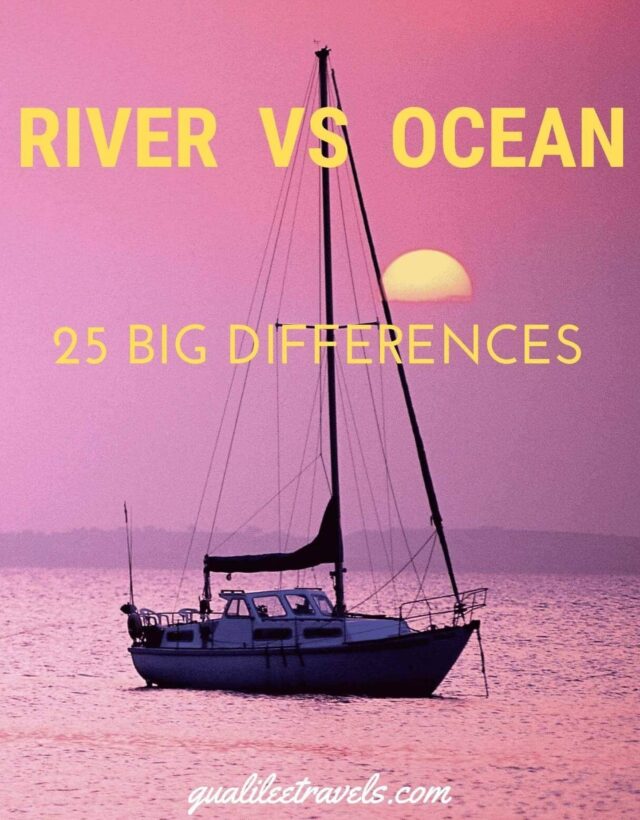Cruising is one of the most popular ways to explore the world, but the experience can vary greatly depending on whether you choose a river or ocean cruise. Both offer unique advantages and cater to different types of travelers. Here’s a deep dive into the 25 big differences between river and ocean cruises.
1. Size of the Ship
- River Cruises: Typically, river cruise ships are smaller, often accommodating between 100-200 passengers. This smaller size allows them to navigate narrow waterways and dock in the heart of cities.
- Ocean Cruises: Ocean cruise ships are much larger, with some of the biggest vessels holding thousands of passengers. These floating resorts are equipped with extensive amenities and entertainment options.
2. Destinations
- River Cruises: Focus on inland waterways, allowing travelers to explore iconic cities, small towns, and countryside regions. Popular routes include the Rhine, Danube, and Seine rivers.
- Ocean Cruises: Primarily cover coastal regions and islands. They often visit a mix of large cities and remote destinations, such as the Caribbean islands, Mediterranean coast, and Alaskan wilderness.
3. Port Accessibility
- River Cruises: Ships can dock in the center of towns and cities, providing immediate access to local attractions.
- Ocean Cruises: Ports are often located outside city centers, requiring additional transport to reach major attractions.
4. Excursions
- River Cruises: Excursions are typically more intimate and culturally focused, often included in the fare. Guests can expect walking tours, visits to historic sites, and local cultural experiences.
- Ocean Cruises: Offer a wide range of excursions, from cultural tours to adventurous activities like snorkeling, hiking, and even helicopter rides. Some excursions may be at an additional cost.
5. Cruise Duration
- River Cruises: Generally shorter, ranging from 7 to 14 days. The focus is on a more leisurely pace with time to explore multiple destinations deeply.
- Ocean Cruises: Can range from 3-day getaways to months-long world cruises. They often cover greater distances, visiting multiple countries and continents.
6. Scenery
- River Cruises: Constantly changing landscapes, with views of rolling hills, vineyards, castles, and quaint villages right outside your window.
- Ocean Cruises: Offer vast ocean views with occasional glimpses of islands, coastal towns, and marine life.
7. Onboard Entertainment
- River Cruises: Entertainment is usually more low-key, focusing on local musicians, lectures, and cultural performances.
- Ocean Cruises: Offer a wide array of entertainment options, including Broadway-style shows, casinos, nightclubs, and various themed parties.
8. Dining Experience
- River Cruises: Dining is often a more intimate affair with regional specialties and locally sourced ingredients. Meals are typically served in a single dining room with open seating.
- Ocean Cruises: Offer a variety of dining options, from buffet-style eateries to specialty restaurants. Larger ships may have multiple dining venues, each with its own theme and cuisine.
9. Passenger Demographics
- River Cruises: Tend to attract older, more experienced travelers who appreciate a slower pace and cultural immersion.
- Ocean Cruises: Draw a more diverse crowd, including families, couples, and solo travelers of all ages. The wide range of activities caters to various interests.
10. Cost
- River Cruises: Generally more expensive per day, reflecting the smaller, more intimate experience and often all-inclusive nature.
- Ocean Cruises: Offer a wider range of price points, from budget-friendly options to luxury experiences. Costs can vary depending on the ship size, itinerary, and cabin choice.
11. Cabin Size and Variety
- River Cruises: Cabins are generally smaller and more uniform in size, though suites with balconies are available on newer ships.
- Ocean Cruises: Offer a wide variety of cabin types, from inside staterooms to expansive suites with private balconies and butler service.
12. Vessel Stability
- River Cruises: Rivers are calm, with little to no motion, making these cruises ideal for those prone to seasickness.
- Ocean Cruises: The ocean’s waves can cause motion, though larger ships are equipped with stabilizers to minimize the effect.
13. Seasonality
- River Cruises: Operate primarily during the warmer months, with a special focus on European Christmas market cruises in December.
- Ocean Cruises: Operate year-round, with itineraries tailored to the seasons, such as Caribbean cruises in winter and Mediterranean cruises in summer.
14. Passenger Interaction
- River Cruises: The smaller ship size fosters a more intimate atmosphere, encouraging social interaction among passengers.
- Ocean Cruises: With more passengers on board, there’s less pressure to interact, but plenty of opportunities to meet others during group activities and events.
15. Amenities
- River Cruises: Limited onboard amenities due to the ship’s size, typically including a lounge, small gym, and possibly a spa.
- Ocean Cruises: Feature extensive amenities such as multiple pools, fitness centers, spas, sports courts, and sometimes even ice skating rinks or rock climbing walls.
16. Environmental Impact
- River Cruises: Generally have a smaller environmental footprint, thanks to smaller ships and shorter distances traveled.
- Ocean Cruises: Larger ships and longer distances can result in a higher environmental impact, though many lines are implementing greener practices.
17. Crew-to-Passenger Ratio
- River Cruises: Often have a higher crew-to-passenger ratio, allowing for more personalized service.
- Ocean Cruises: The ratio can vary widely, but luxury ocean cruises often match the high service levels found on river cruises.
18. Cultural Immersion
- River Cruises: Offer deep cultural immersion with daily shore excursions that focus on the history, art, and traditions of the regions visited.
- Ocean Cruises: Provide cultural experiences, but often with a broader, more generalized approach due to the variety of destinations.
19. Customization
- River Cruises: Offer fewer options for customization, with most itineraries and activities being pre-set.
- Ocean Cruises: Provide a high level of customization, with choices in dining, activities, excursions, and even onboard entertainment.
20. Family-Friendliness
- River Cruises: Less suited for families with young children, as onboard activities and excursions are more adult-oriented.
- Ocean Cruises: Often cater to families, with kids’ clubs, family-friendly excursions, and entertainment suitable for all ages.
21. Safety
- River Cruises: Generally considered safer due to the calm and controlled nature of rivers, with easy access to shore in case of emergency.
- Ocean Cruises: Advanced safety measures are in place, but the open ocean presents more variables, such as weather and sea conditions.
22. Atmosphere
- River Cruises: Offer a relaxed, intimate atmosphere with a focus on relaxation and cultural exploration.
- Ocean Cruises: Can range from laid-back to lively, depending on the ship and itinerary. There’s often a greater variety of atmospheres to choose from.
23. Themed Cruises
- River Cruises: Often offer themed itineraries, such as wine-tasting cruises, history-focused tours, or Christmas market trips.
- Ocean Cruises: Also offer themed cruises but with a wider variety of options, including music festivals, celebrity-hosted voyages, and wellness retreats.
24. Packing Requirements
- River Cruises: Require more casual, comfortable clothing suitable for walking tours and cultural experiences.
- Ocean Cruises: Depending on the cruise line and itinerary, you may need to pack for a wider range of activities, from formal nights to beach outings.
25. Wi-Fi and Connectivity
- River Cruises: Generally offer more reliable Wi-Fi, as the proximity to land ensures better signal strength.
- Ocean Cruises: Wi-Fi can be spotty and expensive, especially in the middle of the ocean, though it is improving with advancements in satellite technology.
Choosing between a river and an ocean cruise isn’t just about deciding where you’d like to travel it’s about defining the kind of experience you want to have. River cruises offer a deeply immersive, intimate journey where every day brings you closer to the heart of a region’s culture and history. Ocean cruises, on the other hand, are grand adventures that sweep you across vast seas, offering a dynamic mix of exploration, relaxation, and entertainment.
Understanding these differences can transform your travel experience from good to extraordinary. Whether you’re seeking the quiet charm of meandering through historic rivers or the thrill of navigating open waters to far-off lands, the right cruise can be the trip of a lifetime. Your choice will shape your memories, your experiences, and ultimately, the stories you tell long after the journey ends. So, set your sights on the cruise that resonates with your spirit of adventure—and prepare for a voyage like no other.











